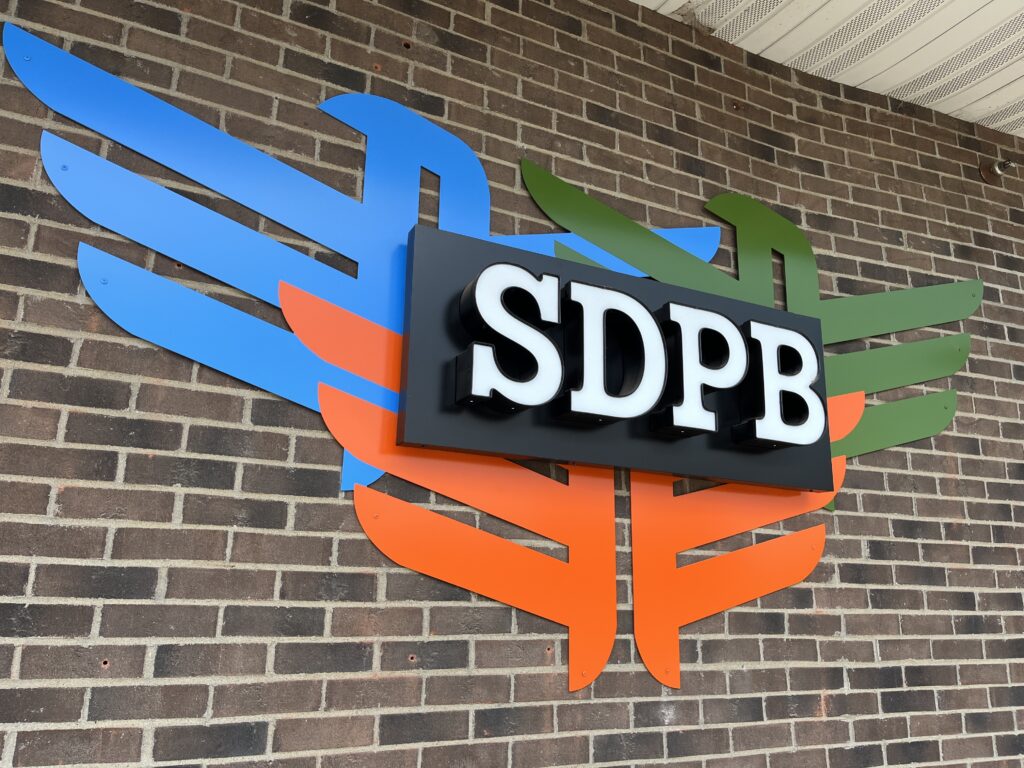
South Dakota Public Broadcasting’s logo at its downtown Sioux Falls studio. (Makenzie Huber/South Dakota Searchlight)
South Dakota Public Broadcasting is bracing for potential cuts and layoffs after Congress canceled $1.1 billion in previously approved nationwide funding for public media.
The federal funding went to the Corporation for Public Broadcasting, which distributes money to local stations. SDPB depends on $2.2 million in annual funding from the corporation, which is about 20% of SDPB’s budget. State funds account for a little more than half of SDPB’s budget, while fundraising, private donations and other sources make up the rest.
Because the federal funding was previously approved, SDPB was counting on it to arrive in the months ahead.
“I don’t think it’s realistic to raise an additional $2.2 million on 75 days’ notice,” said Ryan Howlett, CEO of Friends of SDPB, a nonprofit that raises money for SDPB. He added that donor support increased in recent weeks.
US House sends bill to Trump yanking funding for NPR, PBS, foreign aid; SD congressman votes yes
SDPB provides non-commercial public radio and television across South Dakota. In addition to news coverage, the organization provides live video and audio feeds of legislative and state government meetings, educational content, cultural programming, high school activities broadcasts, and emergency alerts across the state.
The congressional legislation, which President Donald Trump is expected to sign into law, also cancels $8 billion in foreign aid. It’s the second time in more than three decades that Congress approved a presidential recission request.
Julie Overgaard, SDPB executive director, said if funding isn’t replaced, the organization will reduce staff by 20 to 25%. South Dakota Public Broadcasting employs about 60 people, meaning up to 15 people could lose their jobs.
Overgaard said she was raised on “Sesame Street” and “Mr. Rogers’ Neighborhood” in a “poor rural household” in northwest Iowa. She said public broadcasting is what readied her for school, since she didn’t have access to the same resources as more affluent, urban areas of the state.
Overgaard said the cuts will have “real, long-lasting, damaging impacts” on South Dakota. Trump and some congressional Republicans have accused National Public Radio and the Public Broadcasting Service of bias in their news coverage.
“I don’t think this is about bias in media,” Overgaard said in an SDPB interview. “I think this is about trying to shutter and change people’s access to information, to public safety, to education, to things that make a big, big difference.”
Rounds, Johnson explain support for recission
The three members of Congress from South Dakota, who are all Republicans, each voted in favor of rescinding the funding for public broadcasting.
Sen. Mike Rounds announced his support after securing a handshake deal earlier this week with the White House budget director to transfer $9.4 million to Native American radio stations in rural areas across 11 states.
In a statement to South Dakota Searchlight, Rounds said SDPB and tribal stations both provide critical alerts and public safety information for the state. But he said tribal radio stations receive up to 92% of their operating budgets from the Corporation for Public Broadcasting.
“These rural tribal stations that provide potentially lifesaving alerts would not survive without assistance from the federal government,” Rounds said. “SDPB receives financial support through donations to Friends of SDPB that assist with their operating costs.
Rounds also said in a press release that with “nearly $37 trillion in federal debt, we must preserve essential services but also take meaningful steps to reduce wasteful spending.”
Overgaard said she was surprised to see Rounds rally funding for tribal radio stations but not other rural broadcasters.
Native Public Media CEO Loris Taylor wrote in an editorial that the organization is grateful for Sen. Rounds proposing alternatives, but said the solution found “is neither administratively feasible nor fiscally sustainable in the short term.”
Rep. Dusty Johnson “understands the importance of public broadcasting in South Dakota,” said spokesperson Kristen Blakely, and he applauded Rounds’ effort to help tribes. Johnson said in an interview with C-SPAN this week that he had concerns about the impact on rural and reservation areas of the state. Rounds’ deal made adjustments regarding those concerns, he said.
The office of Senate Majority Leader John Thune did not immediately respond to a request for comment.
SDPB doesn’t expect state to fill funding gap
SDPB escaped then-Gov. Kristi Noem’s proposed $3.6 million cut in state funding this winter. State dollars pay for the infrastructure and engineering of the public media network. Friends of SDPB largely pays for national programming, while grants from the corporation support local programming.
Lawmakers on budget committee reject Noem’s public broadcasting cut
Overgaard said there was resounding support from the public and Legislature for SDPB during the legislative session.
“If you take away one leg of our three-legged stool, it puts a lot of pressure on the other two legs to pick up the slack,” Overgaard said.
State Rep. Jack Kolbeck, R-Sioux Falls, sits on the legislative budget committee and fought against the proposed state cut. The committee will meet next week, where Kolbeck hopes to hear more about how the federal cuts will affect SDPB.
“I listen to SDPB a lot,” Kolbeck said. “I’m not in favor of them getting to the point where they can’t operate.”
Overgaard doesn’t expect the state or its taxpayers to “be forced or make up for the decisions our congressional delegation made.” She plans to advocate for public media funding in the upcoming federal budget process and seek other funding sources, such as donations and grants.
“I know it’s going to be another tight budget year. I will not be asking or expecting them to come up with $2 million,” Overgaard said of legislators. “We will have to solve that ourselves.”
Keep following this and other statewide stories: Sign up for our free newsletter.


